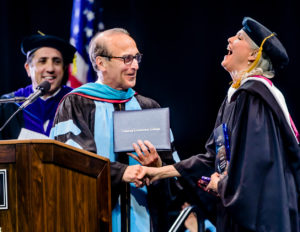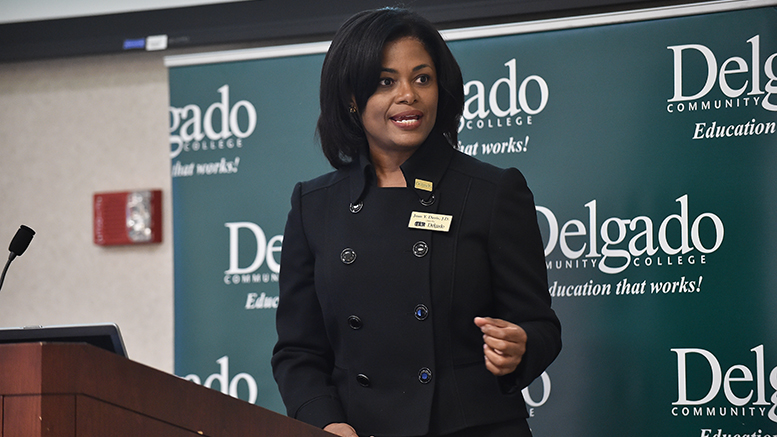Ten years ago, Delgado Community College in New Orleans received about 70 percent of its revenue from state funding, Chancellor Joan Davis says.
Now, that figure sits at 30 percent. And students can only bear so many tuition hikes before something has to give.
Last spring, that “something” took the form of staff and program cuts. Under a directive from the Louisiana Community and Technical College System, Davis and her executive council took a hard look at how they could reduce costs by cutting some underperforming programs. After a thorough review, they decided to drop six programs whose costs outweighed the benefits.
The decision meant 14 employees would lose their jobs. Not surprisingly, the students, staff and other community members who were directly affected by the cuts were upset. Davis met with many of them in person to explain her thinking.
“I got a lot of requests not to close those programs,” she says. “When I could, I responded directly to let people know this wasn’t something we wanted to do. It was something we had to do to be as effective as possible.”
She adds: “Those weren’t among my favorite days, I’ll tell you that.”
Beware the fallout
Cutting programs and laying off staff is one of the hardest parts of a community college president’s job. Not only is it emotional for everyone involved, but the political fallout can be damaging as well.
“People may protest. If you’re in a state with organized labor, the union may file a grievance,” says Brent Knight, president of Lansing Community College in Michigan. “And there is a considerable impact on morale.”
Like other college presidents, Knight views layoffs as a last resort. He prefers to find other solutions to reducing labor costs, such as not filling positions when they become vacant. But that’s not always an option, and Knight has had to lay off staff in the past. When that happens, he says, college presidents must be ready for the pushback that is sure to follow.
This excerpt comes from the current issue of AACC’s Community College Journal.
How campus leaders arrive at the difficult choice to cut staff and programs, and how they communicate their decision to stakeholders, can make a big difference in how well the news is received, those who have gone through the experience say.
While the process is never easy, community college leaders can soften the blow by having a good reason for their decision, being open and honest with stakeholders, and not hiding from criticism.
Perception matters
To reduce the likelihood of tension, college leaders should exhaust other options for cutting their budgets first, Knight says. That means forgoing any unnecessary spending. It sends the wrong message to the campus community if people are losing their jobs while it’s business as usual elsewhere in the college.

When layoffs happen, presidents must be ready for the pushback that typically follows, says Brent Knight, president of Lansing Community College. (Photo: LCC)
“Eight years ago, when we had a reduction in force, I didn’t travel anywhere that year,” Knight observes. “It’s not a good time to be hosting dinners or buying things you can live without.”
Public perception was high on President Cristobal Valdez’s mind when he had to make difficult staffing decisions at Richland Community College in Illinois.
A standoff between the governor and state lawmakers meant that Illinois had no state budget for two straight years. By the time Illinois finally passed a budget for the 2018 fiscal year, state funding accounted for only 6 percent of Richland’s budget.
Making matters worse, the college had seen its enrollment fall by 27 percent during that same period. In preparing a budget for the 2017-18 school year, Valdez knew he had to reduce expenses dramatically.
An analysis revealed the college was spending 80 percent of its budget on personnel. To keep the college sustainable over the long term, “industry standards say that figure should be closer to 70 percent,” Valdez says.
Start with the administration
To make personnel cuts in the most humane way possible, Richland offered a voluntary early separation package to all employees who were at least 50 years old and had worked at the college for at least 10 years. That helped, but it wasn’t enough—and Valdez knew he needed to lay off some employees.
Aware of how the cuts would be perceived by faculty and students, he focused first on administrative staff. For instance, the college had a workforce development division with its own vice president. Valdez eliminated the vice president’s position and moved the division under the vice president of academic services. He also consolidated the director of payroll and director of human resources into a single position.
After cutting five executive positions and accepting early separations from more than two dozen staff members, the college also laid off 18 employees to help trim $1.4 million from its budget. Cutting senior administrators in addition to faculty helped with the optics of the situation, and Valdez also showed stakeholders that he didn’t have any alternatives.
“We had already cut our travel and professional development budgets, and our faculty were feeling disconnected from their professional duties because they were missing out on training opportunities. We had moved our hardware refresh cycle back from five to eight years, and we were experiencing computer failures,” Valdez notes.
“I tried to explain to folks that we couldn’t cut these non-personnel items any longer. People were anxious and dismayed, but I think they understood why we had to make those changes.”

